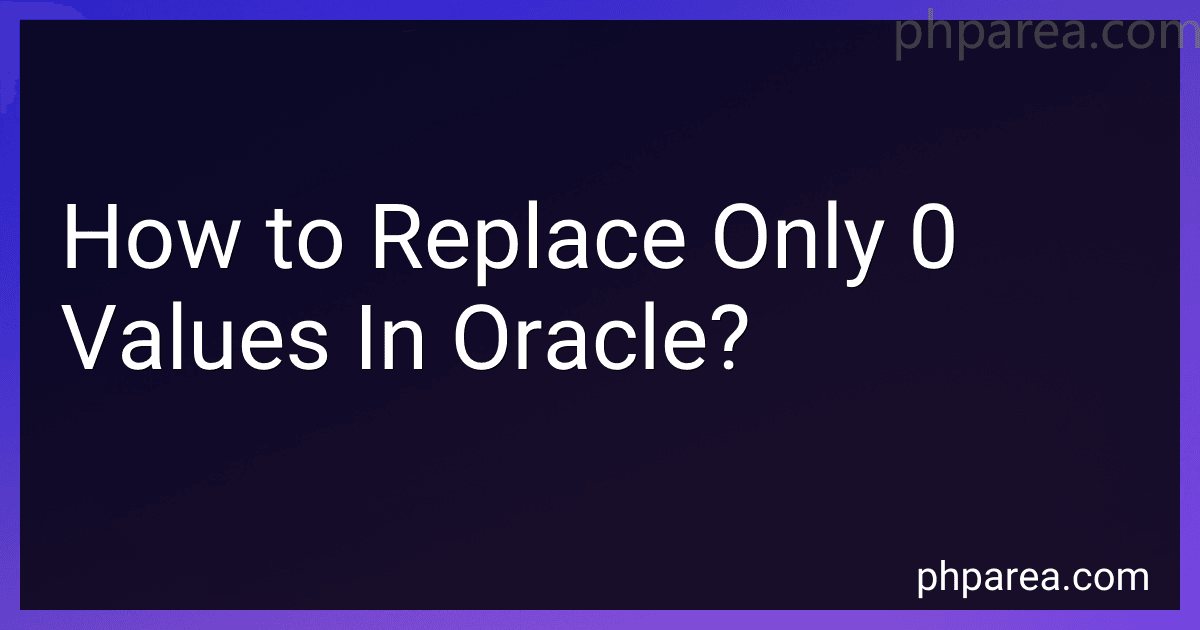Posts (page 9)
-
 3 min readTo generate a random character in Oracle, you can use the DBMS_RANDOM package. The function DBMS_RANDOM.STRING can be used to generate a random string of characters of a specified length. For example, you can use the following SQL query to generate a random character:SELECT SUBSTR(DBMS_RANDOM.STRING('P', 1), 1, 1) AS random_char FROM dual;This query will return a single random character as the result. You can adjust the length parameter in the DBMS_RANDOM.
3 min readTo generate a random character in Oracle, you can use the DBMS_RANDOM package. The function DBMS_RANDOM.STRING can be used to generate a random string of characters of a specified length. For example, you can use the following SQL query to generate a random character:SELECT SUBSTR(DBMS_RANDOM.STRING('P', 1), 1, 1) AS random_char FROM dual;This query will return a single random character as the result. You can adjust the length parameter in the DBMS_RANDOM.
-
 5 min readIn Oracle, you can display row data as columns by using the PIVOT clause in your SQL query. This allows you to transform row data into a more readable column format. You can pivot the data based on a specific column, using aggregation functions like SUM, COUNT, AVG, etc.
5 min readIn Oracle, you can display row data as columns by using the PIVOT clause in your SQL query. This allows you to transform row data into a more readable column format. You can pivot the data based on a specific column, using aggregation functions like SUM, COUNT, AVG, etc.
-
 3 min readTo get the previous working day from an Oracle database, you can use the TRUNC function to remove the time portion of a date, and then use the CASE statement to check if the previous day is a Saturday or Sunday. If it is, you can return the previous business day by subtracting an additional day. Finally, you can use the result in your query to retrieve data related to the previous working day from the database.
3 min readTo get the previous working day from an Oracle database, you can use the TRUNC function to remove the time portion of a date, and then use the CASE statement to check if the previous day is a Saturday or Sunday. If it is, you can return the previous business day by subtracting an additional day. Finally, you can use the result in your query to retrieve data related to the previous working day from the database.
-
 9 min readTo automate image storing on Oracle database, you can use a combination of tools and technologies such as Oracle PL/SQL, SQL scripts, and possibly a programming language like Java or Python.One approach is to create a script or program that will connect to the Oracle database, read the image files from a given directory or source, convert them into binary format, and then insert them into a specific table in the database.
9 min readTo automate image storing on Oracle database, you can use a combination of tools and technologies such as Oracle PL/SQL, SQL scripts, and possibly a programming language like Java or Python.One approach is to create a script or program that will connect to the Oracle database, read the image files from a given directory or source, convert them into binary format, and then insert them into a specific table in the database.
-
 4 min readTo parse CLOB data in Oracle, you can use the DBMS_LOB package, which provides procedures and functions to handle large objects like CLOBs. You can use the DBMS_LOB package to extract and manipulate the content of CLOB columns in Oracle tables.One common method to parse CLOB data is to use the DBMS_LOB.SUBSTR function, which allows you to extract a substring of the CLOB data based on a specified offset and length.
4 min readTo parse CLOB data in Oracle, you can use the DBMS_LOB package, which provides procedures and functions to handle large objects like CLOBs. You can use the DBMS_LOB package to extract and manipulate the content of CLOB columns in Oracle tables.One common method to parse CLOB data is to use the DBMS_LOB.SUBSTR function, which allows you to extract a substring of the CLOB data based on a specified offset and length.
-
 6 min readTo replace only 0 values in Oracle, you can use the UPDATE statement with a CASE expression. Here's an example query:UPDATE table_name SET column_name = CASE WHEN column_name = 0 THEN new_value ELSE column_name END WHERE column_name = 0;In this query, table_name is the name of the table you want to update, column_name is the name of the column containing the values you want to replace, and new_value is the value you want to replace the 0 values with.
6 min readTo replace only 0 values in Oracle, you can use the UPDATE statement with a CASE expression. Here's an example query:UPDATE table_name SET column_name = CASE WHEN column_name = 0 THEN new_value ELSE column_name END WHERE column_name = 0;In this query, table_name is the name of the table you want to update, column_name is the name of the column containing the values you want to replace, and new_value is the value you want to replace the 0 values with.
-
 3 min readTo calculate the sum of multiple columns in Oracle, you can use the SQL SUM() function along with the + operator to add the values of each column.
3 min readTo calculate the sum of multiple columns in Oracle, you can use the SQL SUM() function along with the + operator to add the values of each column.
-
 7 min readTo connect Oracle to Laravel, you will first need to install the required Oracle drivers for PHP. You can do this by downloading the Oracle Instant Client from the Oracle website and then installing the necessary PHP extension for connecting to Oracle databases.Once you have installed the Oracle drivers, you can configure Laravel to connect to your Oracle database by updating the database configuration file (config/database.php).
7 min readTo connect Oracle to Laravel, you will first need to install the required Oracle drivers for PHP. You can do this by downloading the Oracle Instant Client from the Oracle website and then installing the necessary PHP extension for connecting to Oracle databases.Once you have installed the Oracle drivers, you can configure Laravel to connect to your Oracle database by updating the database configuration file (config/database.php).
-
 7 min readTo execute multiple queries in Oracle, you can use a PL/SQL block or a script to combine multiple SQL statements. You can use the BEGIN and END keywords to define a block of code, and use semicolons to separate each SQL statement within the block. You can also use anonymous blocks to execute multiple queries in a single transaction. Another way is to create a stored procedure or function that contains the multiple queries, and then call the procedure or function to execute the queries.
7 min readTo execute multiple queries in Oracle, you can use a PL/SQL block or a script to combine multiple SQL statements. You can use the BEGIN and END keywords to define a block of code, and use semicolons to separate each SQL statement within the block. You can also use anonymous blocks to execute multiple queries in a single transaction. Another way is to create a stored procedure or function that contains the multiple queries, and then call the procedure or function to execute the queries.
-
 6 min readThere are several strategies that can be implemented to improve the performance of Oracle inserts.One approach is to use bulk insert operations instead of single row inserts. This can be achieved by using the INSERT INTO ... SELECT syntax or by using the FORALL statement in PL/SQL to process multiple rows at once.Another strategy is to minimize the number of indexes on the table being inserted into, as each index adds overhead to the insert operation.
6 min readThere are several strategies that can be implemented to improve the performance of Oracle inserts.One approach is to use bulk insert operations instead of single row inserts. This can be achieved by using the INSERT INTO ... SELECT syntax or by using the FORALL statement in PL/SQL to process multiple rows at once.Another strategy is to minimize the number of indexes on the table being inserted into, as each index adds overhead to the insert operation.
-
 4 min readTo remove duplicate values of a group in Oracle SQL, you can use the DISTINCT keyword in your query. This keyword eliminates duplicate rows from the result set, so you will only get unique values for the specified group. You can also use the GROUP BY clause to group the results based on a particular column or set of columns, and then apply the DISTINCT keyword to remove any duplicate values within each group.
4 min readTo remove duplicate values of a group in Oracle SQL, you can use the DISTINCT keyword in your query. This keyword eliminates duplicate rows from the result set, so you will only get unique values for the specified group. You can also use the GROUP BY clause to group the results based on a particular column or set of columns, and then apply the DISTINCT keyword to remove any duplicate values within each group.
-
 5 min readTo create a table based on multiple tables in Oracle, you can use the CREATE TABLE AS statement. This statement allows you to create a new table by selecting data from one or more existing tables. You can specify the columns you want to include in the new table and use queries to extract data from the multiple tables.For example, you can create a new table by combining data from two existing tables using a query like this: CREATE TABLE new_table AS SELECT table1.column1, table1.column2, table2.
5 min readTo create a table based on multiple tables in Oracle, you can use the CREATE TABLE AS statement. This statement allows you to create a new table by selecting data from one or more existing tables. You can specify the columns you want to include in the new table and use queries to extract data from the multiple tables.For example, you can create a new table by combining data from two existing tables using a query like this: CREATE TABLE new_table AS SELECT table1.column1, table1.column2, table2.